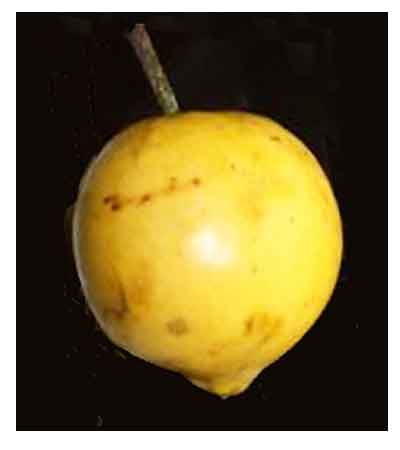 Gen info Gen info
- Garcinia is a genus of flowering plants in the family Clusiaceae, native to Asia, America, Australia, tropical ad southern Africa, and Polynesia. The number of species is in dispute; Plants of the World Online recognizes up to 400 species. Plants in the genus are called saptrees, mangosteens, or garcinias.
(4)
-
Etymology: The genus Garcinia is named after Laurent Garcin (1685-1752), French botanist, naturalist and plant collector. The species epithet nervosa means 'conspicuously veined', a reference to the leaf's venation. (3)
Botany
Garcinia nervosa is an evergreen medium-large, mid-canopy rainforest tree, up to 30 m height. Crown conical, relatively open, with tiered horizontal branching. Branches typically restricted to upper parts of crown in wild trees. All parts of plant exude yellowish latex when bruised. Leaves are opposite, stoutly stalked, leaf blades leathery, oblong, with strongly-ribbed abaxial veins, and 22–60 by 9–25.5 cm. Young leaves reddish, maturing to whitish-green, then green. Stems strongly 4-ridged. Flowers grow in large clusters, with separate male and female flowers. Each flower is small, with creamy-white fleshy petals, scented like lime or sour milk, opening at dusk, Female flowers more strongly-scented, with sterile stamens and producing lots of honey. Fruits are pear-shaped to round, to 8 cm wide, ripening from green to blotchy or pale yellow and contain up to five red seeds in the white pulp. (3)
Distribution
- Native to the Philippines.
- Also native to Andaman Is., Borneo, Malaya, Nicobar Is., Sumatera. (2)
- Grows primarily in the wet tropical biome. (2)
 Constituents Constituents
- Study of stem bark isolated one new pyranoxanthone derivative, garner xanthone (1), and five other compounds i.e., 1,5-dihydroxyxanthone (2), 6-deoxyisojacareubin (3), 12b-hydroxy-des-D-garcigerrin A (4), stigmasterol (5), and ß-sitosterol (6). Crude extracts were assessed for antimicrobial activity. (6)
- Study of leaves isolated a novel chalcone 5'-bromo-2'-hydroxy-4,4',6'-trimethoxy-chalcone,
isoliquiritigenin-4,4′-dimethyl ether (2′-hydroxy- 4,4′-dimethoxy chalcone) and 2′-hydroxy-3,4,4′,6′-tetramethoxy dihydrochalcone. (7)
-
Study of leaves isolated a biflavonoid, its structure elucidated as I-5, II-5, I-7, II-7, I-3′, I-4′, II-4′-heptahydroxy-[I-3, II-8]-flavanonylflavone. (8)
- Study of bark isolated two new polyisoprenylated acylphlorogluciinols, 7-epi-isoxanthochymol and 7-epi-cycloxanthochymol (1 – 2), together with their 7-epimers isoxanthochymol (3) and cycloxanthochymol (4). (see study below) (9)
- Approximate composition of fruits yielded moisture content 80.6%, total ash 0.8%, total carbohydrate 14.1% dry weight, crude protein 3.9%, crude fat 0.6%, and crude fiber 6.1%.
(10)
- Bioassay guided study of leaves isolated a new biflavonoid, II-3,I-5, II-5,II-7,I-4',II-4'-hexahydroxy-(I-3,II-8)-flavonylflavanonol, together with two known flavonoids, 6-methyl-4'-methoxyflavone and acacetin. (see study below)
(11)
Properties
- Studies have suggested anti-inflammatory, antioxidant, cytotoxicity, anticancer, platelet activating factor inhibitory, enzyme inhibitory, antigout properties.
Parts used
Leaves, bark.
Uses
Edibility
- Fruits are edible.
Folkloric
- No reported folkloric medicinal use in the Philippines.
- Leaves pounded to a paste, boiled in coconut oil, and rubbed on body and joints for pain relief. (3)
 Studies Studies
• Antioxidant / Anti-Inflammatory / Cytotoxic / Leaves and Bark: Study evaluated the antioxidant, anti-inflammatory, and cytotoxic effects of methanolic extracts from air-dried grounded leaves and bark. Results showed high radical scavenging activities by DPPH assay. Both extracts showed high anti-inflammatory properties using lipoxygenase assay, hyaluronidase assay, and xanthine oxidase assay. The bark extract showed high inhibition of enzyme activity by lipoxygenase assay. The bark extract exhibited moderate antigout properties in the xanthine oxidase assay. On cytotoxicity assay, the extracts showed positive responses against three cancer cell lines viz. HeLa, MCF-77 and HT-29 cell lines. (5)
• Cytotoxicity Against Cancer Cell Lines / Polyisoprenylated Acylphloroglucinols / Bark: Study of bark isolated two new polyisoprenylated acylphlorogluciinols, 7-epi-isoxanthochymol and 7-epi-cycloxanthochymol (1 – 2), together with their 7-epimers isoxanthochymol (3) and cycloxanthochymol (4). All compounds showed cytotoxic activity against HL-60, MCF-7 (human breast adenocarcinoma), A549 (human lung adenocarcinoma) and HepG2 (human hepatocellular carcinoma) cells. (9)
• Inhibitory Effect on Platelet Activating Factor / Biflavonoid / Leaves: A methanol extract of leaves showed strong inhibitory effects on platelet-activating factor (PAF) receptor binding. Bioassay guided study isolated a new biflavonoid, II-3,I-5, II-5,II-7,I-4',II-4'-hexahydroxy-(I-3,II-8)-flavonylflavanonol, together with two known flavonoids, 6-methyl-4'-methoxyflavone and acacetin. The biflavonoid and acacetin showed strong inhibition of PAF receptor binding to rabbit platelets using 3H-PAF as ligand, with IC50s of 28.0 and 20.4 µM respectively. Study suggests the compounds are responsible for the strong PAF antagonistic activity of the plant. (11)
Availability
Wild-crafted. |

![]()





 Studies
Studies 